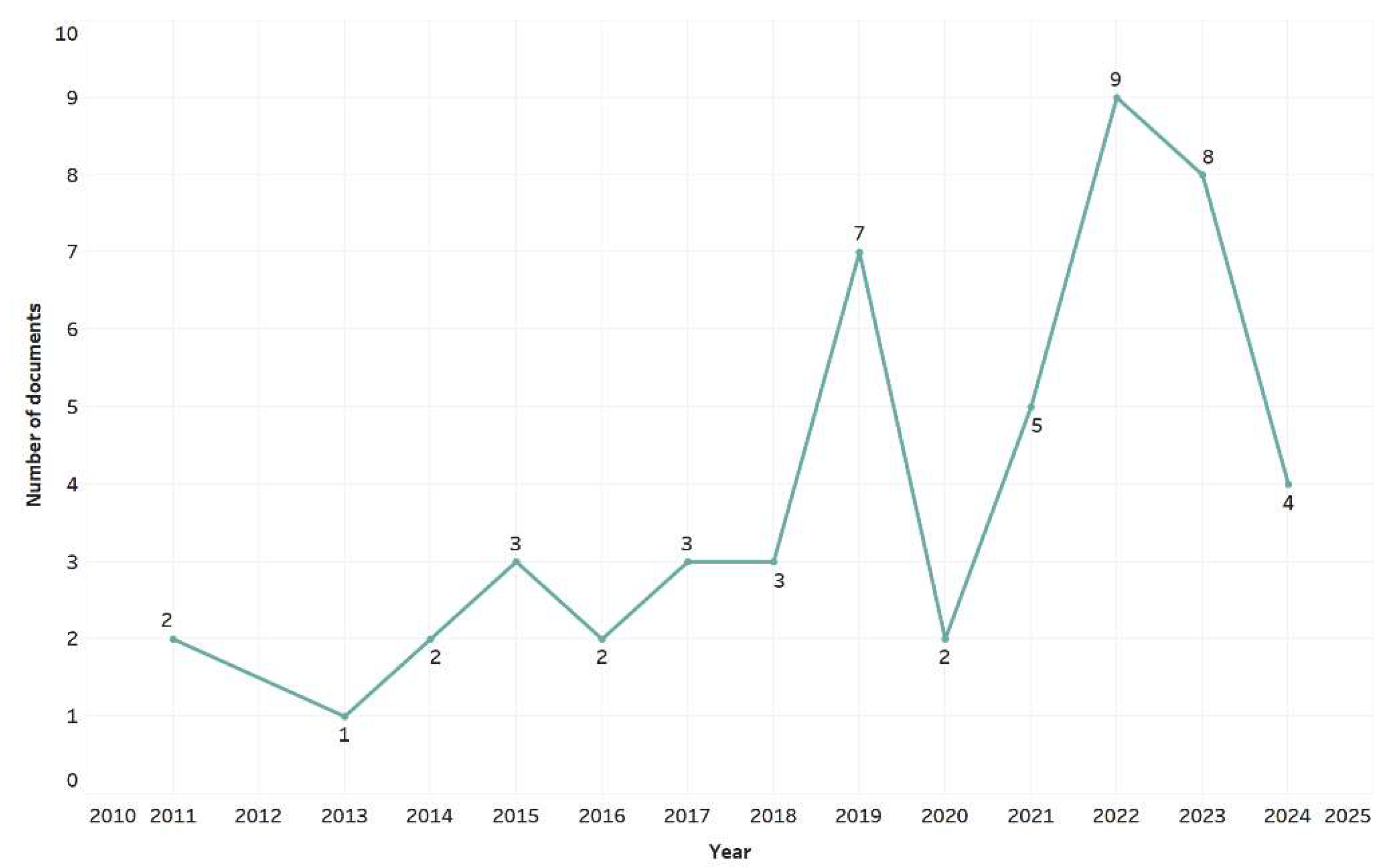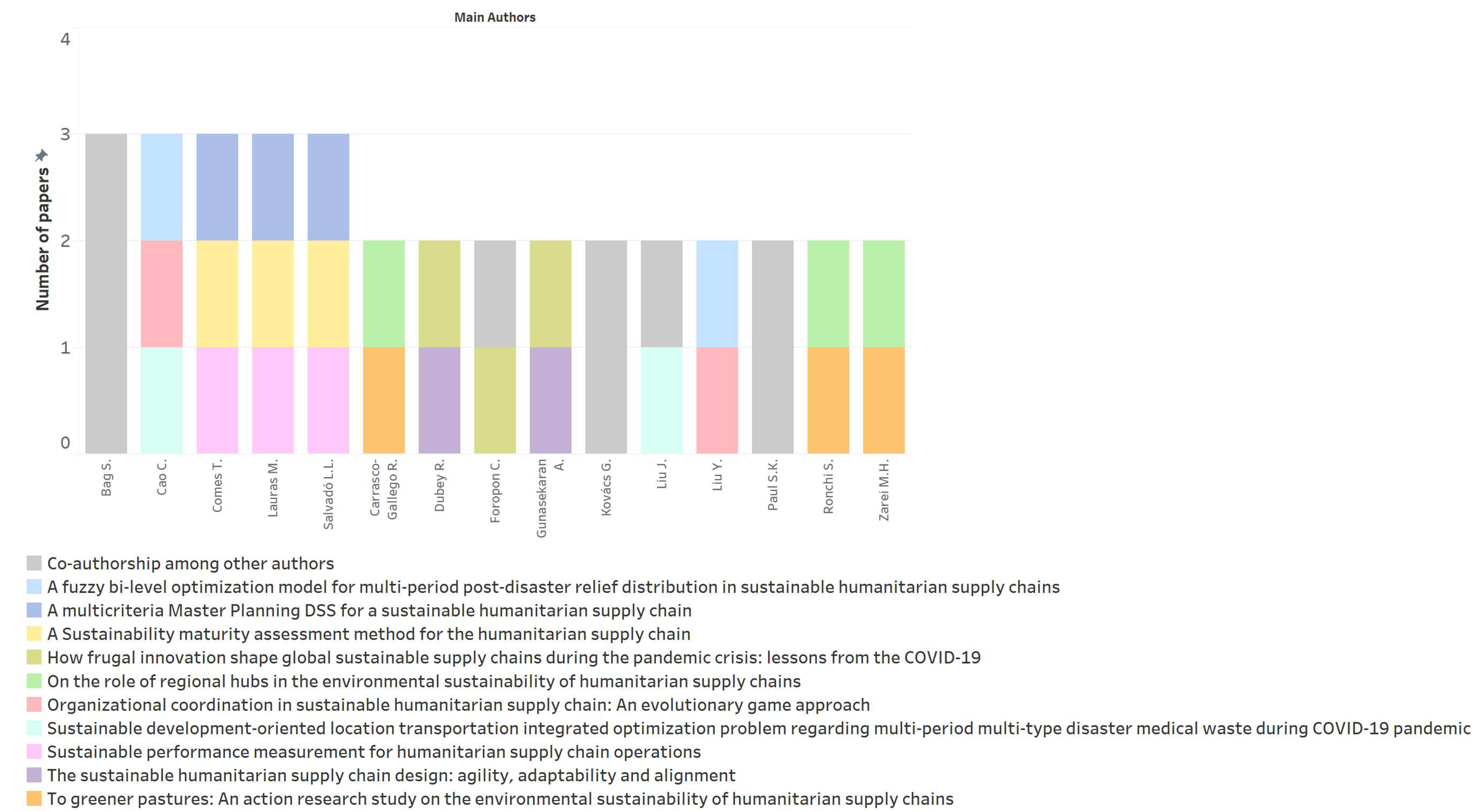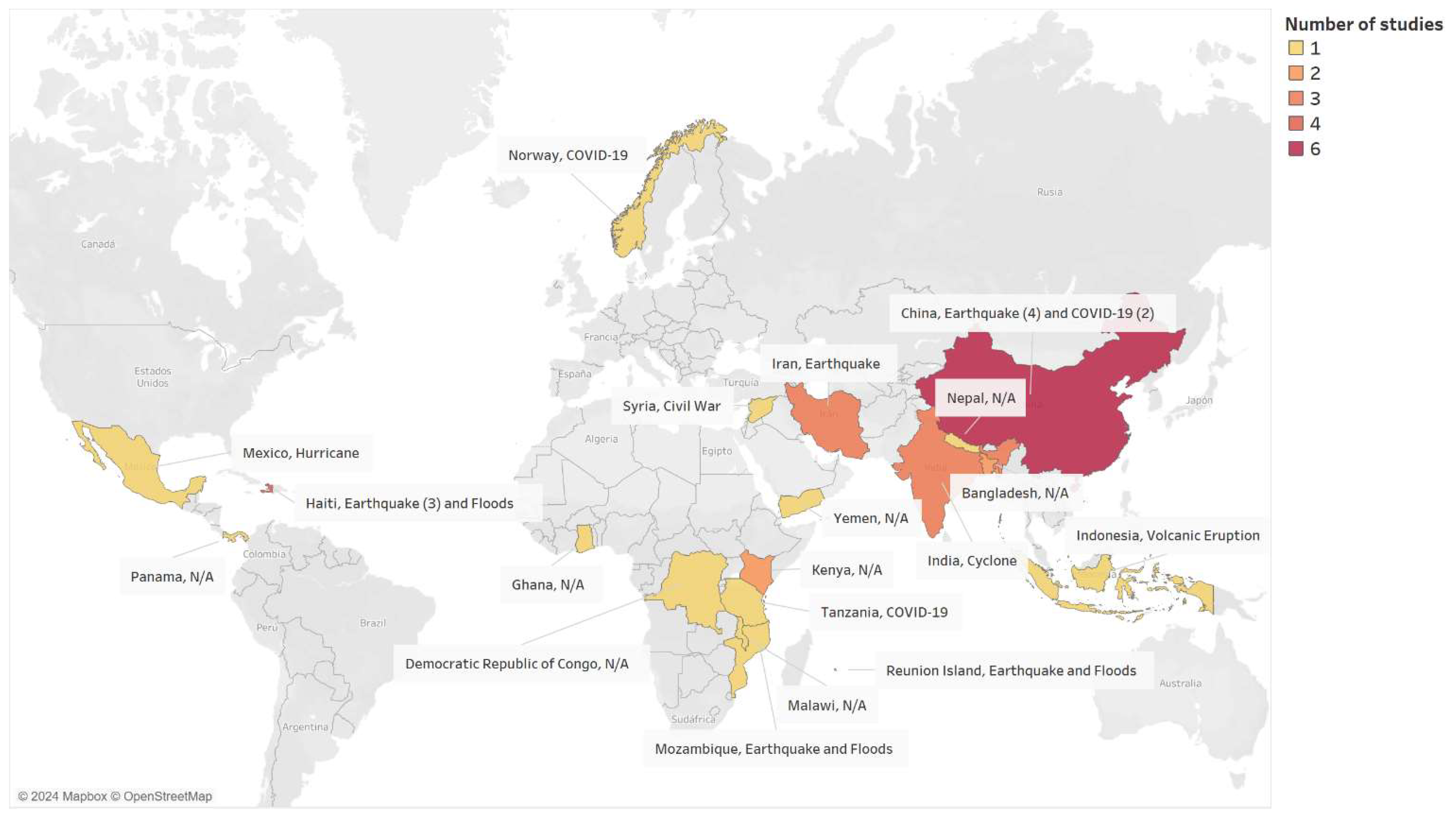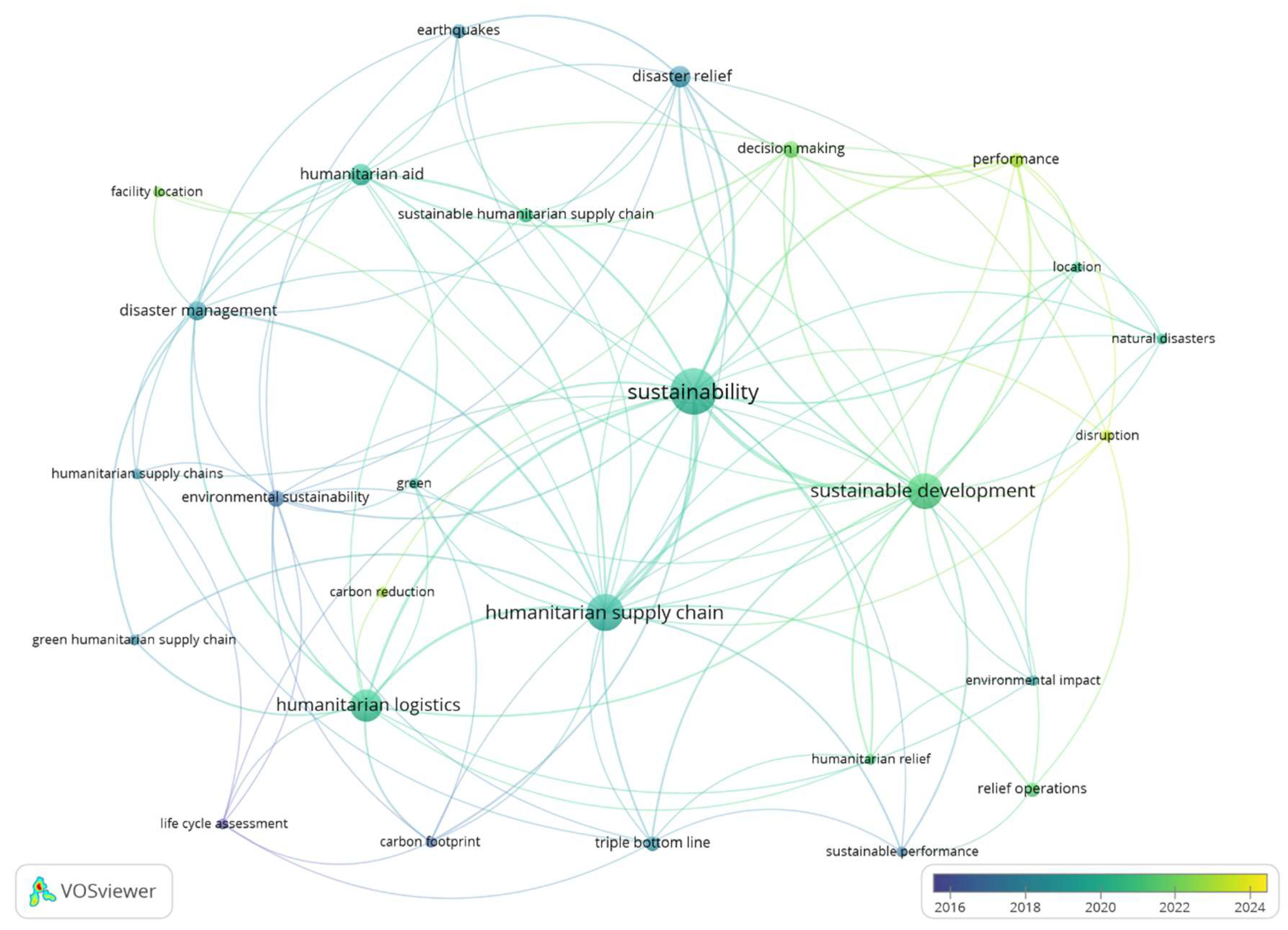Transforming Humanitarian Supply Chains Through Green Practices: A Systematic Review
Abstract
1. Introduction
2. Positioning
3. Methodology
3.1. First Stage: Research Methodology
3.2. Second Stage: Study Selection
4. Descriptive Analysis
5. Discussion
- 1.
- What is the current state of the literature on green humanitarian supply chains?
| Reference | Case Study | Mixed Approaches | Multi-Criteria Decision-Making | Quantitative | Qualitative | ||||||||
|---|---|---|---|---|---|---|---|---|---|---|---|---|---|
| Mathematical Approaches | Simulation | Statistical Analysis | Life Cycle Assessment | Conceptual | Interviews | Survey | Focused Groups | Action Research | Field Research | ||||
| [22] | √ | √ | √ | √ | |||||||||
| [21] | √ | √ | |||||||||||
| [23] | √ | √ | √ | √ | √ | ||||||||
| [16] | √ | √ | |||||||||||
| [24] | √ | √ | √ | √ | |||||||||
| [25] | √ | √ | √ | ||||||||||
| [26] | √ | √ | |||||||||||
| [27] | √ | ||||||||||||
| [28] | √ | √ | √ | ||||||||||
| [29] | √ | √ | |||||||||||
| [18] | |||||||||||||
| [14] | √ | √ | |||||||||||
| [15] | √ | √ | √ | ||||||||||
| [30] | √ | √ | √ | ||||||||||
| [31] | √ | √ | √ | √ | |||||||||
| [32] | √ | ||||||||||||
| [33] | √ | √ | |||||||||||
| [17] | √ | √ | |||||||||||
| [34] | √ | √ | |||||||||||
| [35] | √ | √ | √ | ||||||||||
| [36] | √ | ||||||||||||
| [37] | √ | √ | |||||||||||
| [38] | √ | √ | |||||||||||
| [39] | √ | √ | |||||||||||
| [39] | √ | √ | |||||||||||
| [40] | √ | √ | |||||||||||
| [41] | √ | √ | |||||||||||
| [42] | √ | √ | |||||||||||
| [13] | √ | √ | |||||||||||
| [43] | √ | ||||||||||||
| [44] | √ | √ | √ | ||||||||||
| [45] | √ | √ | |||||||||||
| [46] | √ | √ | |||||||||||
| [47] | √ | √ | √ | ||||||||||
| [48] | √ | √ | √ | √ | |||||||||
| [49] | √ | √ | |||||||||||
| [50] | √ | ||||||||||||
| [51] | √ | √ | √ | ||||||||||
| [52] | √ | √ | √ | ||||||||||
| [53] | √ | √ | √ | ||||||||||
| [54] | √ | ||||||||||||
| [55] | √ | √ | √ | ||||||||||
| [20] | √ | ||||||||||||
| [56] | √ | √ | |||||||||||
| [57] | √ | √ | |||||||||||
| [58] | √ | √ | |||||||||||
| [59] | √ | ||||||||||||
| [60] | √ | √ | √ | ||||||||||
| [61] | √ | ||||||||||||
| [12] | √ | √ | |||||||||||
| [11] | √ | ||||||||||||
- 2.
- What role do green logistics practices play in reducing environmental impacts and minimizing carbon emissions in disaster relief?
- 3.
- What are the barriers to effective green humanitarian supply chain practices?
- 4.
- What are the potential avenues for future research in this field?
6. Conclusions
Author Contributions
Funding
Data Availability Statement
Conflicts of Interest
Abbreviations
| GHSC | Green Humanitarian Supply Chain. |
| DSS | Decision Support System. |
| UN | United Nations. |
| OCHA | Office for the Coordination of Humanitarian Affairs. |
References
- OCHA Global Humanitarian Overview 2024. Available online: https://www.unocha.org/publications/report/world/global-humanitarian-overview-2024-enarfres (accessed on 31 January 2025).
- Besiou, M.; Pedraza-Martinez, A.J.; Van Wassenhove, L.N. Humanitarian Operations and the UN Sustainable Development Goals. Prod. Oper. Manag. 2021, 30, 4343–4355. [Google Scholar] [CrossRef]
- Ülkü, M.A.; Bookbinder, J.H.; Yun, N.Y. Leveraging Industry 4.0 Technologies for Sustainable Humanitarian Supply Chains: Evidence from the Extant Literature. Sustainability 2024, 16, 1321. [Google Scholar] [CrossRef]
- Shrivastav, S.K.; Bag, S. Humanitarian Supply Chain Management in the Digital Age: A Hybrid Review Using Published Literature and Social Media Data. Benchmarking 2024, 31, 2267–2301. [Google Scholar] [CrossRef]
- Nawazish, M.; Nandakumar, M.K.; Mateen, A. Are Humanitarian Supply Chains Sustainable? A Systematic Review and Future Research Themes. Benchmarking 2024, 31, 2565–2601. [Google Scholar] [CrossRef]
- Anjomshoae, A.; Banomyong, R.; Hossein Azadnia, A.; Kunz, N.; Blome, C. Sustainable Humanitarian Supply Chains: A Systematic Literature Review and Research Propositions. Prod. Plan. Control 2023, 36, 357–377. [Google Scholar] [CrossRef]
- Ertem, M.A.; İşbilir, M.; Şahin Arslan, A. Review of Intermodal Freight Transportation in Humanitarian Logistics. Eur. Transp. Res. Rev. 2017, 9, 10. [Google Scholar] [CrossRef]
- Cook, D.; Mulrow, C.; Haynes, B. Systematic Reviews: Synthesis of Best Evidence for Clinical Decisions. Ann. Intern. Med. 1997, 126, 376–380. [Google Scholar] [CrossRef]
- Tranfield, D.; Denyer, D.; Smart, P. Towards a Methodology for Developing Evidence-Informed Management Knowledge by Means of Systematic Review. Br. J. Manag. 2003, 14, 207–222. [Google Scholar] [CrossRef]
- Page, M.J.; McKenzie, J.E.; Bossuyt, P.M.; Boutron, I.; Hoffmann, T.C.; Mulrow, C.D.; Shamseer, L.; Tetzlaff, J.M.; Akl, E.A.; Brennan, S.E.; et al. The PRISMA 2020 statement: An updated guideline for reporting systematic reviews. BMJ 2021, 372, n71. [Google Scholar] [CrossRef] [PubMed]
- Eng-Larsson, F.; Vega, D. Green Logistics in Temporary Organizations: A Paradox? Learnings from the Humanitarian Context. Supply Chain Forum Int. J. 2011, 12, 128–139. [Google Scholar] [CrossRef]
- Sarkis, J.; Spens, K.; Kovács, G. A Study of Barriers to Greening the Relief Supply Chain. Supply Chain Forum Int. J. 2011, 196–207. [Google Scholar] [CrossRef]
- Laguna-Salvadó, L.; Lauras, M.; Okongwu, U.; Comes, T. A Multicriteria Master Planning DSS for a Sustainable Humanitarian Supply Chain. Ann. Oper. Res. 2019, 283, 1303–1343. [Google Scholar] [CrossRef]
- Liang, S.; Bai, X.; Li, Y.; Xin, H. Model and Solution of Sustainable Bi-Level Emergency Commodity Allocation Based on Type-2 Fuzzy Theory. Socio Econ. Plan. Sci. 2023, 90, 101749. [Google Scholar] [CrossRef]
- Jamali, A.; Ranjbar, A.; Heydari, J.; Nayeri, S. A Multi-Objective Stochastic Programming Model to Configure a Sustainable Humanitarian Logistics Considering Deprivation Cost and Patient Severity. Ann. Oper. Res. 2022, 319, 1265–1300. [Google Scholar] [CrossRef]
- Ahmad, M.S.; Fei, W.; Shoaib, M.; Ali, H. Identification of Key Drivers for Performance Measurement in Sustainable Humanitarian Relief Logistics: An Integrated Fuzzy Delphi-DEMATEL Approach. Sustainability 2024, 16, 4412. [Google Scholar] [CrossRef]
- Agarwal, S.; Kant, R.; Shankar, R. Exploring Sustainability Balanced Scorecard for Performance Evaluation of Humanitarian Organizations. Clean. Logist. Supply Chain 2022, 3, 100026. [Google Scholar] [CrossRef]
- Jafarzadeh-Ghoushchi, S.; Asghari, M.; Mardani, A.; Simic, V.; Tirkolaee, E.B. Designing an Efficient Humanitarian Supply Chain Network during an Emergency: A Scenario-Based Multi-Objective Model. Socio Econ. Plan. Sci. 2023, 90, 101716. [Google Scholar] [CrossRef]
- Karuppiah, K.; Sankaranarayanan, B.; Ali, S.M.; Paul, S.K. Key Challenges to Sustainable Humanitarian Supply Chains: Lessons from the Covid-19 Pandemic. Sustainability 2021, 13, 5850. [Google Scholar] [CrossRef]
- Battini, D.; Peretti, U.; Persona, A.; Sgarbossa, F. Sustainable Humanitarian Operations: Closed-Loop Supply Chain. Int. J. Serv. Oper. Manag. 2016, 25, 65–79. [Google Scholar] [CrossRef]
- Shakibaei, H.; Moosavi, S.A.; Aghsami, A.; Rabbani, M. Designing a Sustainable-Resilient Humanitarian Supply Chain for Post-Disaster Relief Process, an Earthquake Case Study in Haiti. J. Humanit. Logist. Supply Chain Manag. 2024, 14, 349–368. [Google Scholar] [CrossRef]
- Chowdhury, M.M.H.; Paul, S.K.; Khan, E.A.; Shakil Mahmud, A.K.M. A Decision Support Model for Barriers and Optimal Strategy Design in Sustainable Humanitarian Supply Chain Management. Glob. J. Flex. Syst. Manag. 2024, 25, 467–486. [Google Scholar] [CrossRef]
- Sallwa, A.A. Supply Chain Gaps Analysis during COVID-19 Pandemic—The Case of Medical Supplies in Tanzania. J. Humanit. Logist. Supply Chain Manag. 2024, 14, 82–89. [Google Scholar] [CrossRef]
- Andoh, E.A.; Yu, H. A Two-Stage Decision-Support Approach for Improving Sustainable Last-Mile Cold Chain Logistics Operations of COVID-19 Vaccines. Ann. Oper. Res. 2023, 328, 75–105. [Google Scholar] [CrossRef] [PubMed]
- Rodríguez-Espíndola, O.; Dey, P.; Albores, P.; Chowdhury, S. Sustainability and Intermodality in Humanitarian Logistics: A Two-Stage Multi-Objective Programming Formulation. Ann. Oper. Res. 2023, 346, 1687–1716. [Google Scholar] [CrossRef]
- Mittal, R.; Obaid, A. Sustainable Warehouse Location Selection in Humanitarian Supply Chain: Multi-Criteria Decision-Making Approach. Int. J. Math. Eng. Manag. Sci. 2023, 8, 316–335. [Google Scholar] [CrossRef]
- Grassa, R.; Bocanet, A. Developing a Sustainable Operation Management System for Food Charity Organizations. J. Clean. Prod. 2023, 428, 139447. [Google Scholar] [CrossRef]
- Saari, S. Enhancing the Environmental Sustainability of Emergency Humanitarian Medical Cold Chains with Renewable Energy Sources. J. Humanit. Logist. Supply Chain Manag. 2023, 13, 157–172. [Google Scholar] [CrossRef]
- Mosallanezhad, B.; Hajiaghaei-Keshteli, M.; Smith Cornejo, N.R.; Rodríguez Calvo, E.Z. An IoMT Platform for an Integrated Sustainable Energy-Efficient Disaster Relief Supply Chain to Prevent Severity-Driven Disruptions during Pandemics. J. Ind. Inf. Integr. 2023, 35, 100502. [Google Scholar] [CrossRef]
- Desi-Nezhad, Z.; Sabouhi, F.; Dehghani Sadrabadi, M.H. An Optimization Approach for Disaster Relief Network Design under Uncertainty and Disruption with Sustainability Considerations. RAIRO Oper. Res. 2022, 56, 751–768. [Google Scholar] [CrossRef]
- Bag, S.; Gupta, S.; Wood, L. Big Data Analytics in Sustainable Humanitarian Supply Chain: Barriers and Their Interactions. Ann. Oper. Res. 2022, 319, 721–760. [Google Scholar] [CrossRef]
- Fuli, G.; Foropon, C.; Xin, M. Reducing Carbon Emissions in Humanitarian Supply Chain: The Role of Decision Making and Coordination. Ann. Oper. Res. 2022, 319, 355–377. [Google Scholar] [CrossRef]
- Cao, C.; Li, J.; Liu, J.; Liu, J.; Qiu, H.; Zhen, J. Sustainable Development-Oriented Location-Transportation Integrated Optimization Problem Regarding Multi-Period Multi-Type Disaster Medical Waste during COVID-19 Pandemic. Ann. Oper. Res. 2022, 335, 1401–1447. [Google Scholar] [CrossRef]
- Tasnim, Z.; Hamid, A.B.A.; Dwivedi, Y.K.; Shareef, M.A. Sustainable Disaster Supply Chain Management for Relief Operations in Bangladesh. J. Humanit. Logist. Supply Chain Manag. 2022, 12, 285–304. [Google Scholar] [CrossRef]
- Abbas, H.; Asim, Z.; Ahmed, Z.; Moosa, S. Exploring and Establishing the Barriers to Sustainable Humanitarian Supply Chains Using Fuzzy Interpretive Structural Modeling and Fuzzy MICMAC Analysis. Soc. Responsib. J. 2022, 18, 1463–1484. [Google Scholar] [CrossRef]
- Dubey, R.; Bryde, D.J.; Foropon, C.; Tiwari, M.; Gunasekaran, A. How Frugal Innovation Shape Global Sustainable Supply Chains during the Pandemic Crisis: Lessons from the COVID-19. Supply Chain Manag. 2022, 27, 295–311. [Google Scholar] [CrossRef]
- Cao, C.; Liu, Y.; Tang, O.; Gao, X. A Fuzzy Bi-Level Optimization Model for Multi-Period Post-Disaster Relief Distribution in Sustainable Humanitarian Supply Chains. Int. J. Prod. Econ. 2021, 235, 108081. [Google Scholar] [CrossRef]
- Boostani, A.; Jolai, F.; Bozorgi-Amiri, A. Designing a Sustainable Humanitarian Relief Logistics Model in Pre- and Postdisaster Management. Int. J. Sustain. Transp. 2021, 15, 604–620. [Google Scholar] [CrossRef]
- Sopha, B.M.; Triasari, A.I.; Cheah, L. Sustainable Humanitarian Operations: Multi-Method Simulation for Large-Scale Evacuation. Sustainability 2021, 13, 7488. [Google Scholar] [CrossRef]
- Patil, A.; Shardeo, V.; Dwivedi, A.; Madaan, J.; Varma, N. Barriers to Sustainability in Humanitarian Medical Supply Chains. Sustain. Prod. Consum. 2021, 27, 1794–1807. [Google Scholar] [CrossRef]
- Bag, S.; Luthra, S.; Venkatesh, V.G.; Yadav, G. Towards Understanding Key Enablers to Green Humanitarian Supply Chain Management Practices. Manag. Environ. Qual. Int. J. 2020, 31, 1111–1145. [Google Scholar] [CrossRef]
- Chen, F.; Liu, S.; Appolloni, A. Horizontal Coordination of I-LNGOs in the Humanitarian Supply Chain: An Evolutionary Game Approach. Sustainability 2020, 12, 5953. [Google Scholar] [CrossRef]
- Kaur, H.; Singh, S.P. Sustainable Procurement and Logistics for Disaster Resilient Supply Chain. Ann. Oper. Res. 2019, 283, 309–354. [Google Scholar] [CrossRef]
- Zhang, J.; Liu, H.; Yu, G.; Ruan, J.; Chan, F.T.S. A Three-Stage and Multi-Objective Stochastic Programming Model to Improve the Sustainable Rescue Ability by Considering Secondary Disasters in Emergency Logistics. Comput. Ind. Eng. 2019, 135, 1145–1154. [Google Scholar] [CrossRef]
- Zarei, M.H.; Carrasco-Gallego, R.; Ronchi, S. To Greener Pastures: An Action Research Study on the Environmental Sustainability of Humanitarian Supply Chains. Int. J. Oper. Prod. Manag. 2019, 39, 1193–1225. [Google Scholar] [CrossRef]
- Li, C.; Zhang, F.; Cao, C.; Liu, Y.; Qu, T. Organizational Coordination in Sustainable Humanitarian Supply Chain: An Evolutionary Game Approach. J. Clean. Prod. 2019, 219, 291–303. [Google Scholar] [CrossRef]
- Yadav, D.K.; Barve, A. Prioritization of Cyclone Preparedness Activities in Humanitarian Supply Chains Using Fuzzy Analytical Network Process. Nat. Hazards 2019, 97, 683–726. [Google Scholar] [CrossRef]
- Zarei, M.H.; Carrasco-Gallego, R.; Ronchi, S. On the Role of Regional Hubs in the Environmental Sustainability of Humanitarian Supply Chains. Sustain. Dev. 2019, 27, 846–859. [Google Scholar] [CrossRef]
- Laguna-Salvadó, L.; Lauras, M.; Comes, T. A Sustainability Maturity Assessment Method for the Humanitarian Supply Chain. In Proceedings of the International ISCRAM Conference, APA, Rochester, NY, USA, 20–23 May 2018. [Google Scholar]
- Zhang, B.; Li, H.; Li, S.; Peng, J. Sustainable Multi-Depot Emergency Facilities Location-Routing Problem with Uncertain Information. Appl. Math. Comput. 2018, 333, 506–520. [Google Scholar] [CrossRef]
- Jilani, A.; Ali, Y.; Khan, M.W. Greening of Humanitarian Supply Chain with Focus on Logistics. Int. J. Bus. Perform. Supply Chain Model. 2018, 10, 49–66. [Google Scholar] [CrossRef]
- van Kempen, E.A.; Spiliotopoulou, E.; Stojanovski, G.; de Leeuw, S. Using Life Cycle Sustainability Assessment to Trade off Sourcing Strategies for Humanitarian Relief Items. Int. J. Life Cycle Assess. 2017, 22, 1718–1730. [Google Scholar] [CrossRef]
- Laguna-Salvadó, L.; Lauras, M.; Comes, T. Sustainable Performance Measurement for Humanitarian Supply Chain Operations. In Proceedings of the International ISCRAM Conference, Albi, France, 21–24 May 2017. [Google Scholar]
- Zavvar Sabegh, M.H.; Mohammadi, M.; Naderi, B. Multi-Objective Optimization Considering Quality Concepts in a Green Healthcare Supply Chain for Natural Disaster Response: Neural Network Approaches. Int. J. Syst. Assur. Eng. Manag. 2017, 8, 1689–1703. [Google Scholar] [CrossRef]
- Dubey, R.; Gunasekaran, A. The Sustainable Humanitarian Supply Chain Design: Agility, Adaptability and Alignment. Int. J. Logist. Res. Appl. 2016, 19, 62–82. [Google Scholar] [CrossRef]
- Wei, X.; Al-Refaie, A.; Robles, M.; Noche, B. A Sustainable Humanitarian Relief Network Study for the Wenchuan Earthquake. In Lecture Notes in Logistics; Springer Nature: Berlin, Germany, 2015; pp. 193–213. [Google Scholar]
- Oberhofer, P.; Blanco, E.E.; Craig, A.J. Carbon Efficiency of Humanitarian Supply Chains: Evidence from French Red Cross Operations. In Lecture Notes in Logistics; Springer Nature: Berlin, Germany, 2015; pp. 53–66. [Google Scholar]
- Klumpp, M. Sustainable Humanitarian Logistics Research—A Conceptualization. In Lecture Notes in Logistics; Springer Nature: Berlin, Germany, 2015; pp. 49–63. [Google Scholar]
- Haavisto, I.; Kovács, G. Perspectives on Sustainability in Humanitarian Supply Chains. Disaster Prev. Manag. Int. J. 2014, 23, 610–631. [Google Scholar] [CrossRef]
- Abrahams, D. The Barriers to Environmental Sustainability in Post-Disaster Settings: A Case Study of Transitional Shelter Implementation in Haiti. Disasters 2014, 38, S25–S49. [Google Scholar] [CrossRef]
- Hausladen, I.; Haas, A. Considering Sustainability in the Context of Humanitarian Logistics. Manag. Humanit. Supply Chain. 2013, 314–329. Available online: https://d1wqtxts1xzle7.cloudfront.net/44295936/2013_Preprint_Considering_Sustainability_in_the_Context_of_Humanitarian_Logistics-libre.pdf?1459520507=&response-content-disposition=inline%3B+filename%3DConsidering_Sustainability_in_the_Contex.pdf&Expires=1755141236&Signature=bPZaPLSLEAoB2crwg8~StaFkSYc0OsY4BaqphT49RGCRX0l7d191D2HaUm6BwUmsJrAl3Czis-y5du0F~6ZFXQp3Izm0kg1ZFQDFNY5CjRsHsKMDTpYkki~a1ByWrZIEJlih5q7NvXxbCBsbqamF7A7NbQHORzpTlqNUypKqdCIBLvB4LVyPF1EALU6CpKgKLmc2L6My4o4IXtnpxOwR2aG1~4Mq7gdA3e4XBrRntdHge6SSbtPKU~sQsMfZhvcduYkWyDhvEcVklABI33IKXQMDIQu21Q61f9cWK~SJvJVVzEVy1uIHt741rSQDDIIEe1XzT0oBcm8LNCRamRLJuA__&Key-Pair-Id=APKAJLOHF5GGSLRBV4ZA (accessed on 31 January 2025).





| Research Questions |
|
| Stings | (“carbon” OR “green” OR “environment” OR “sustainab *”) AND (“humanitar *” AND supply chain) |
| Language | English |
| Timeframe | No filter |
| Type of reference | Journal articles (review articles for positioning and research articles) and peer-reviewed conference papers |
| Database | Scopus (broad and high-quality indexing of peer-reviewed journals across disciplines relevant to our topic) |
Disclaimer/Publisher’s Note: The statements, opinions and data contained in all publications are solely those of the individual author(s) and contributor(s) and not of MDPI and/or the editor(s). MDPI and/or the editor(s) disclaim responsibility for any injury to people or property resulting from any ideas, methods, instructions or products referred to in the content. |
© 2025 by the authors. Licensee MDPI, Basel, Switzerland. This article is an open access article distributed under the terms and conditions of the Creative Commons Attribution (CC BY) license (https://creativecommons.org/licenses/by/4.0/).
Share and Cite
Ramirez-Villamil, A.; Jaegler, A. Transforming Humanitarian Supply Chains Through Green Practices: A Systematic Review. Logistics 2025, 9, 115. https://doi.org/10.3390/logistics9030115
Ramirez-Villamil A, Jaegler A. Transforming Humanitarian Supply Chains Through Green Practices: A Systematic Review. Logistics. 2025; 9(3):115. https://doi.org/10.3390/logistics9030115
Chicago/Turabian StyleRamirez-Villamil, Angie, and Anicia Jaegler. 2025. "Transforming Humanitarian Supply Chains Through Green Practices: A Systematic Review" Logistics 9, no. 3: 115. https://doi.org/10.3390/logistics9030115
APA StyleRamirez-Villamil, A., & Jaegler, A. (2025). Transforming Humanitarian Supply Chains Through Green Practices: A Systematic Review. Logistics, 9(3), 115. https://doi.org/10.3390/logistics9030115







